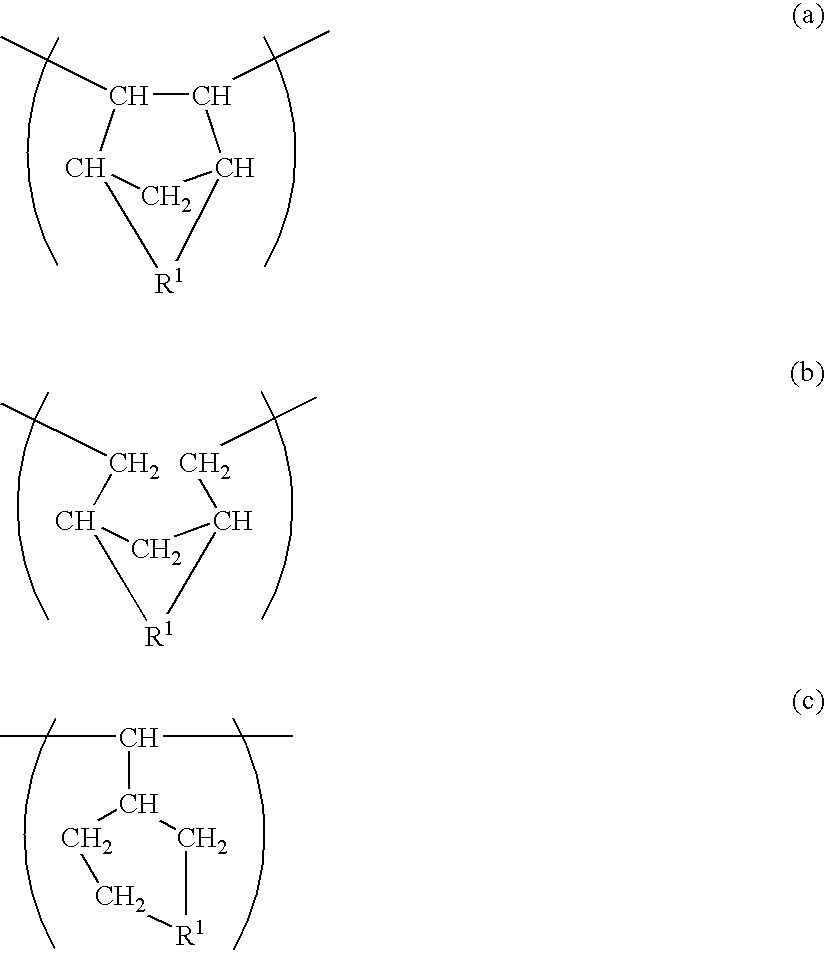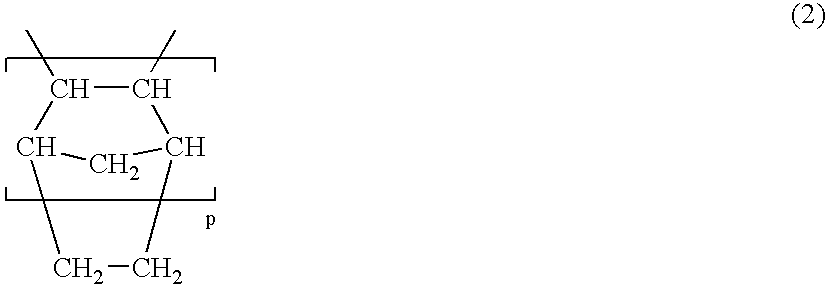Thermoplastic Resin
a technology of thermoplastic resin and thermoplastic material, applied in the field of thermoplastic resin, can solve the problems of difficult development of resins satisfying all the requirements, low water absorption, easy etc., and achieve the effect of low optical anisotropy, not causing deterioration of optical properties, and low optical anisotropy
- Summary
- Abstract
- Description
- Claims
- Application Information
AI Technical Summary
Benefits of technology
Problems solved by technology
Method used
Image
Examples
examples
[0055] Next, the present invention is further described with reference to the following examples, but it should be construed that the invention is not limited to those examples. A measuring method of physical property is performed by following methods.
(1) Melt Flow Rate (MFR)
[0056] A melt flow rate was measured at 260° C. under a load of 2.16 Kg, in accordance with ASTM D1238.
(2) Glass Transition Temperature (Tg)
[0057] A glass transition temperature was measured by heating a sample under the condition of temperature elevation up to 250° C. at a rate of 10° C. / min in nitrogen and then cooling quickly to measure the sample at the rate of 10° C. / min by using DSC-20 (manufactured by Seiko Denshi Kogyo K.K)
(3) Saturated Water Absorption Ratio
[0058] In accordance with ASTM D570, a saturated water absorption ratio was obtained by immersing said molded sheet in distilled water of 23° C. for 1 week, and measuring difference between weight before the immersion and weight after the im...
synthesis examples 1 to 3
[0062] Ethylene-tetracyclo[4.4.0.12,5.17,10]-3-dodecene copolymer was obtained by polymerizing according to a known method using vanadium catalyst (VOCl3). The results of physical properties are shown in table 1.
TABLE 1SaturatedStress-wateropticallight beamSynthesisabsorptioncoefficienttransmittanceexampleMFRTgratioCRin 405 nmNo.g / 10 min° C.%10−12Pa−1%121550.0180852361410.01190883151240.0035088
synthesis examples 4 and 5
[0063] According to a method disclosed in Japanese Unexamined Patent Publication No. 2002-332312, a complex having a structure of the following Formula (2-A) was obtained.
[0064] Ethylene-tetracyclo[4.4.0.12,5.17,10]-3-dodecene copolymer was obtained by polymerizing with this complex as a catalyst and methylaminoxan as an auxiliary catalyst. The results of evaluated physical properties are shown in Table 2.
TABLE 2SaturatedStress-wateropticallight beamSynthesisabsorptioncoefficienttransmittanceexampleMFRTgratioCRin 405 nmNo.g / 10 min° C.%10−12Pa−1%40.61680.0120885601310.0128090
PUM
| Property | Measurement | Unit |
|---|---|---|
| glass transition temperature | aaaaa | aaaaa |
| glass transition temperature | aaaaa | aaaaa |
| light transmittance | aaaaa | aaaaa |
Abstract
Description
Claims
Application Information
 Login to View More
Login to View More - R&D
- Intellectual Property
- Life Sciences
- Materials
- Tech Scout
- Unparalleled Data Quality
- Higher Quality Content
- 60% Fewer Hallucinations
Browse by: Latest US Patents, China's latest patents, Technical Efficacy Thesaurus, Application Domain, Technology Topic, Popular Technical Reports.
© 2025 PatSnap. All rights reserved.Legal|Privacy policy|Modern Slavery Act Transparency Statement|Sitemap|About US| Contact US: help@patsnap.com



